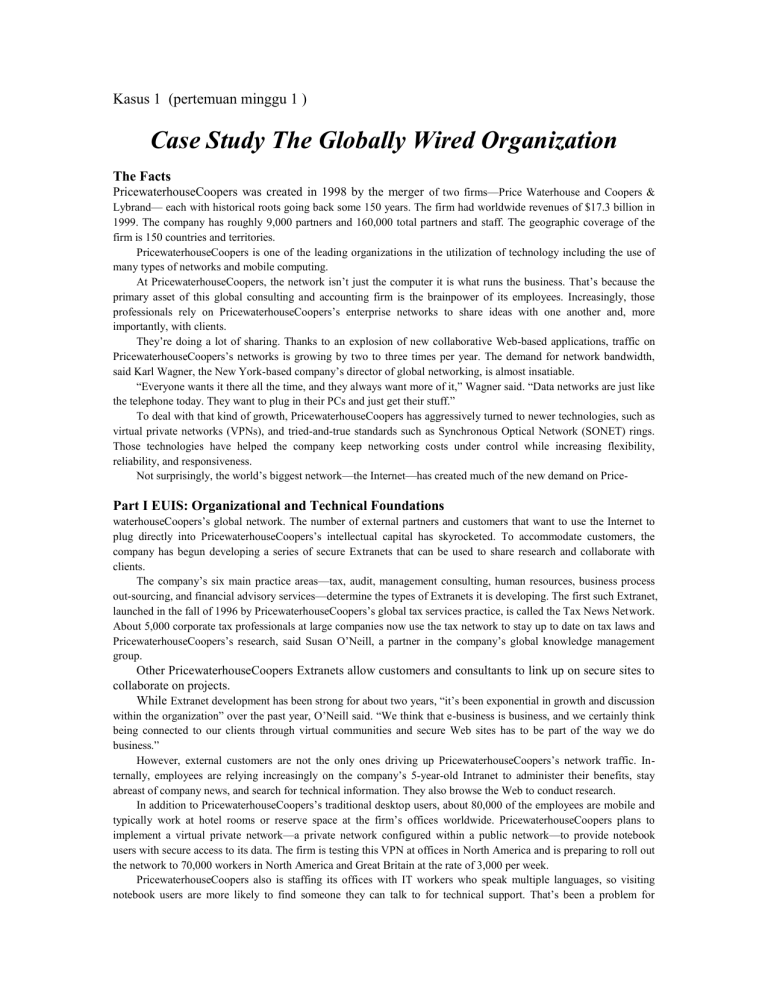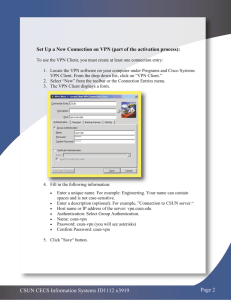Case Study The Globally Wired Organization The Facts

Kasus 1 (pertemuan minggu 1 )
Case Study The Globally Wired Organization
The Facts
PricewaterhouseCoopers was created in 1998 by the merger
of two firms—Price Waterhouse and Coopers &
Lybrand— each with historical roots going back some 150 years. The firm had worldwide revenues of $17.3 billion in
1999. The company has roughly 9,000 partners and 160,000 total partners and staff. The geographic coverage of the firm is 150 countries and territories.
PricewaterhouseCoopers is one of the leading organizations in the utilization of technology including the use of many types of networks and mobile computing.
At PricewaterhouseCoopers, the network isn’t just the computer it is what runs the business. That’s because the primary asset of this global consulting and accounting firm is the brainpower of its employees. Increasingly, those professionals rely on PricewaterhouseCoopers’s enterprise networks to share ideas with one another and, more importantly, with clients.
They’re doing a lot of sharing. Thanks to an explosion of new collaborative Web-based applications, traffic on
PricewaterhouseCoopers’s networks is growing by two to three times per year. The demand for network bandwidth, said Karl Wagner, the New York-based company’s director of global networking, is almost insatiable.
“Everyone wants it there all the time, and they always want more of it,” Wagner said. “Data networks are just like the telephone today. They want to plug in their PCs and just get their stuff.”
To deal with that kind of growth, PricewaterhouseCoopers has aggressively turned to newer technologies, such as virtual private networks (VPNs), and tried-and-true standards such as Synchronous Optical Network (SONET) rings.
Those technologies have helped the company keep networking costs under control while increasing flexibility, reliability, and responsiveness.
Not surprisingly, the world’s biggest network—the Internet—has created much of the new demand on Price-
Part I EUIS: Organizational and Technical Foundations
waterhouseCoopers’s global network. The number of external partners and customers that want to use the Internet to plug directly into PricewaterhouseCoopers’s intellectual capital has skyrocketed. To accommodate customers, the company has begun developing a series of secure Extranets that can be used to share research and collaborate with clients.
The company’s six main practice areas—tax, audit, management consulting, human resources, business process out-sourcing, and financial advisory services—determine the types of Extranets it is developing. The first such Extranet, launched in the fall of 1996 by PricewaterhouseCoopers’s global tax services practice, is called the Tax News Network.
About 5,000 corporate tax professionals at large companies now use the tax network to stay up to date on tax laws and
PricewaterhouseCoopers’s research, said Susan O’Neill, a partner in the company’s global knowledge management group.
Other PricewaterhouseCoopers Extranets allow customers and consultants to link up on secure sites to collaborate on projects.
While
Extranet development has been strong for about two years, “it’s been exponential in growth and discussion within the organization” over the past year, O’Neill said. “We think that e-business is business, and we certainly think being connected to our clients through virtual communities and secure Web sites has to be part of the way we do business.”
However, external customers are not the only ones driving up PricewaterhouseCoopers’s network traffic. Internally, employees are relying increasingly on the company’s 5-year-old Intranet to administer their benefits, stay abreast of company news, and search for technical information. They also browse the Web to conduct research.
In addition to PricewaterhouseCoopers’s traditional desktop users, about 80,000 of the employees are mobile and typically work at hotel rooms or reserve space at the firm’s offices worldwide. PricewaterhouseCoopers plans to implement a virtual private network—a private network configured within a public network—to provide notebook users with secure access to its data. The firm is testing this VPN at offices in North America and is preparing to roll out the network to 70,000 workers in North America and Great Britain at the rate of 3,000 per week.
PricewaterhouseCoopers also is staffing its offices with IT workers who speak multiple languages, so visiting notebook users are more likely to find someone they can talk to for technical support. That’s been a problem for
employees with notebook support needs that arise outside the business hours of their home offices. “If you’re in a hotel room in Taiwan, you’re not going to call your office in Oklahoma,” says Michael Schoenholtz, a partner who oversees global IT support strategies.
The Payoff
The VPN is paying off so far In the United States, the cost of a remote dial-up connection is between $4.20 and $6.10 per hour Through the VPN, the same connection averages about $1.40 per hour for the Internet access provided by an
Internet service provider (ISP).
Along with lowering remote access costs, the VPN pro~‘ides a secure tunnel over the Internet, allowing encrypted data to travel from behind PricewaterhouseCoopers’s firewall to a user who has accessed the Internet through a dial-up connection, another company’s LAN, or a broadband connection at home.
Several thousand PricewaterhouseCoopers employees are using digital subscriber line and cable modem services in conjunction with the VPN to conduct business from their homes. Later this year, PricewaterhouseCoopers will connect three major European offices through a VPN servtce managed by an ISP The corporate locations—in Paris;
London; and Frankfurt, Germany—represent about 20,000 employees.
PricewaterhouseCoopers is at the forefront of global companies realizing that site-to-site VPNs can help bring the costs of their European networks more in line with those in the United States, experts say. In general, the cost of private telecommunications services in Europe is about five times what it costs in the United States.
Accommodating all those new global users and appli cations, however, means a lot more traffic on Pricewater houseCoopers’s LANs and WANs. To help manage it all the company has begun turning to SONET technology.
SONET technology involves the use of fiber optics t connect networks. These networks are sometimes called P or
T3 lines. These networks offer high-speed connection that can transport huge amounts of data quickly.
PricewaterhouseCoopers started using SONET in th~ spring of 1998 at its data centers in Floral Park, New York and Tampa, Florida. The company had started consoli dating its servers for enterprisewide applications, such a Lotus
Development Corp.’s Notes and enterprise resourc planning (ERP) software, into the data centers as a way h cut costs and better manage the applications.
“Once some change happens, either a new applicatioi or a change in business, or, heaven forbid, they combini three offices and forget to tell you, then you’ve got to he abl to respond to that quickly,” Wagner said.
PricewaterhouseCoopers officials expect that thc company’s need for networking bandwidth and flexibilit~ will only increase. The next wave of demand could wel come from the trend toward hosted applications. In addi tion to beginning to provide hosting services to client: through its business process outsourcing practice, Price waterhouse-Coopers has begun using application servic providers.
Currently, in fact, the company is discussing ai arrangement with its ERP vendors and expects to have tin application hosted by the end of the year, said Row an Sny der, the company’s deputy CIO.
With the use of these present technologies and othe advancements on the horizon, PricewaterhouseCooper; truly is becoming a networked organization both digitalh and collaboratively.
Sources:
Hicks, Matt “Keeping Ideas Flowing Pricewoterhouse Coopers turns to VPN, SONET to I’lug Global Users into Its Intellectual Capital,” e Week
(May 8, 2000): 105; Vitiello, Jill, “Road Rage; Companies Are Going after Remote and Mobile Computing with a Vengeance, Creating Lots of Opportunities for IT Pros with the Right Skills,” Computerworld (March 27. 2000): 88;
Davey, Tom, and Amy K. Larsen, ‘The Mobile Infrastructure— As Use of Notebooks Increases, So Does the Demand for Sccuritx and Support,” Iofonuatioo
Week (June 23. 1999): 20.
CASE STUDY QUESTIONS
1. What are some of the ways in which digital networks are changing the way PricewaterhouseCoopers employees work? How have these changes increased their effectiveness? What disadvantages/negatives do you see?
2. What are some of the ways in which digital network are changing PricewaterhouseCooper ‘s relationshiy with partners and clients? What do you think might N some of the results?
CASE STUDY CLASS PROJECTS
1. Check out the PricewaterhouseCoopers Web site. How has PWC implemented some of the changes discussed in this case?
2. Imagine that you or your assigned group are (an) employee(s) at PricewaterhouseCoopers. Using this case,
information in chapter 2, the PricewaterhouseCoopers Web site, and other references regarding the changing digital workplace, create a one- to two-page scenario of a typical day of work on a consulting assignment at
PricewaterhouseCoopers. Make up any details you wish within the context established by the PWC case.
3. Share stories with classmates. Summarize the results by listing and discussing how digital networks are enhancing performance of individuals and groups.


